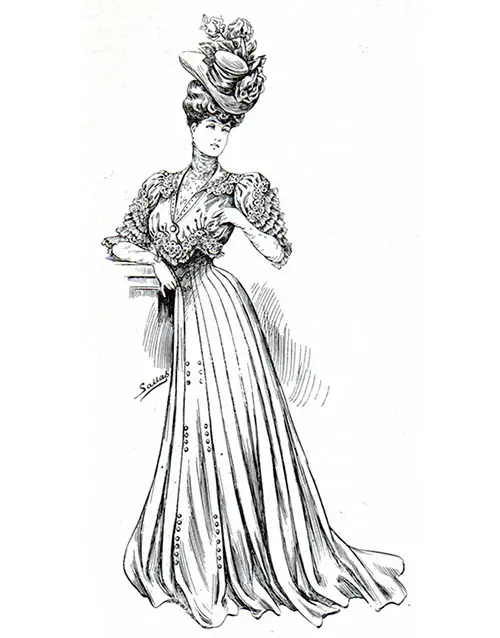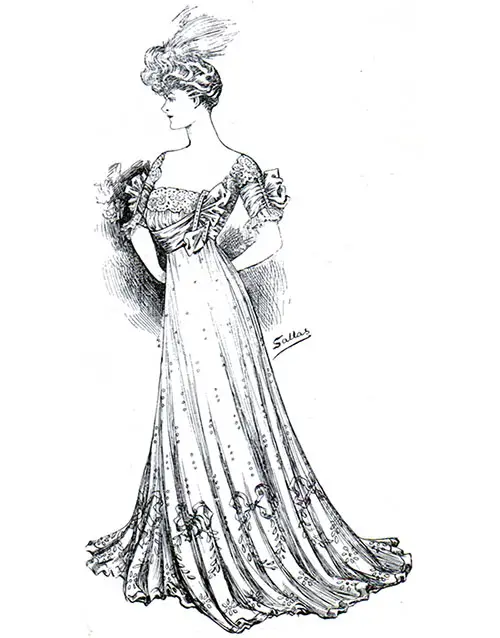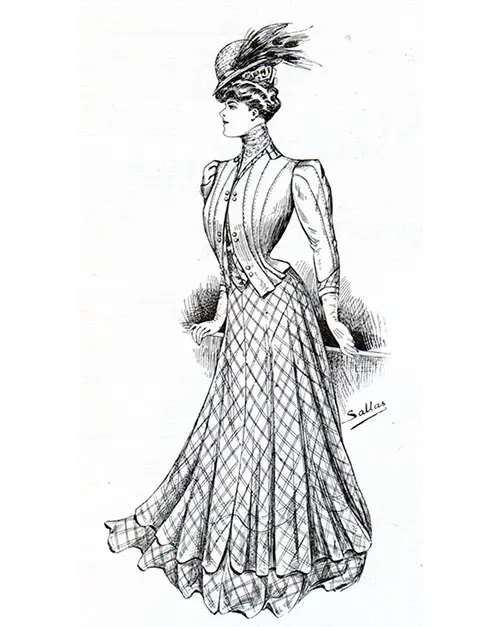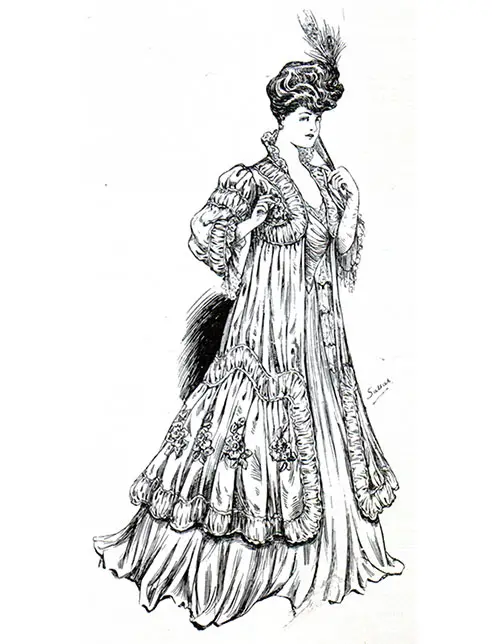World of Dress Fashions 1906
In this 1906 installment, Mrs. Aria (Eliza Davis) reviews the latest fashions for women that were worn in the early 1900s on board the First Saloon and possibly Second-Class sections of the transatlantic steamships.
The World of Dress
By Mrs. Eliza Aira
"The Americans are coming" is on the lips of an expectant Europe, thoroughly accustomed to, and always rejoicing in the annual visit of their liberal and appreciative cousins from over the water.
The London season would not be the London season now a days without the advent of the many from the other side of the Atlantic, while the American hostess, as well as the American visitor, is an established and delightful fact in our social midst.

Mine is happily again the privilege of meeting them halfway and setting forth a full, true, and particular account of the fashions which are awaiting them, together with their welcome.
These are fashions, I am firmly convinced, which will obtain their approval and become them right well, for the figure of the American woman is above all others suited to adorn the corselet skirt and the Princess dress, which are among the most stringent orders of our early spring days.
The Corselet Skirt
The corselet skirt is made long or short, both seamed and strapped, and either plain or interrupted at the waist with little straps to join across and break the line should it prove too hard to meet any individual case with elegance.
Novel Aspects of Blouses
Above the corselet skirts, of course, appears the blouse under many novel aspects, the prominent note being that the blouse should match its skirt, the material chosen being far more diaphanous, either crepe de chine or embroidered chiffon, but of the same tone as the faced cloth—and it is invariably faced cloth—which makes the lower portion of the gown.
Over these little blouses are worn very short boleros well above the waist at the back, slightly above it at the front, trimmed generally with strappings of cloth and bearing some little collar or vest of white pique, or Holland, or Romanian embroidery, or embroidered fine lawn.
The Princess Dress
The Princess dress, which as a rule bears a close resemblance to the corselet skirt, only possessing a deeper corselet portion of more dignified seeming, displays some decoration of strappings, or stitching, or piping down each seam. You could take as a fair example of it that one sketched No. 1 (above) on this page.

It is made of what we are pleased to term the banana shade, which is really our old friend biscuit color rechristened, enamel buttons decorating the center box-pleat, and the little coat being made of taffetas of the same color bearing a waistcoat of the cloth embroidered in gold and green.
It is worn over a shirt of cream-colored lace and crowned with a hat of biscuit-colored chip trimmed with a band of velvet to match and a garland of roses pink, red, and green.
Empire Gowns
We are now devoted to straight lines in our evening dresses as in our day gowns, and that is a good sample of an Empire gown sketched here, not strictly Empire indeed to be historically perfect, yet with a strong suggestion of having been inspired by that fascinating period.
It is of Iris chiffon over satin, and it is embroidered with pale blue and mauve iridescent paillettes, the waistband and bow being made of pale blue ribbon shot with mauve and held with a paste buckle.
Ivory lace outlines the décolletage and trims the sleeves, and it is ivory lace, of a especially attractive aspect bearing a silken embroidery of mauve and blue interspersed with paillettes. On the head of the wearer of this elegance you may observe the latest cry in decoration, the osprey under its most exuberant aspect.
Hats and Coiffures
This special example is in mauve shading to pale blue, but the fashion obtains in every conceivable color, and this in spite of the cry of the humanitarians with no less a personage than Her Majesty at their head to protect the heron from further depredations by unconscionable woman. The osprey and Paradise plume wave their influence over hats and coiffures alike.
On the millinery, indeed, they share favor with a new edition of the peacock's feather, the novelty consisting merely in dye of every color.
No longer is it permitted to exist merely under its natural gorgeous hues of blue and green and gold, but having seized upon these beauties the authorities have decided to desecrate them by submitting them to the dyers' art and encouraging their re-appearance in white and cream, when, by the way, they look exceedingly well; in red and violet when they are extremely ugly; and in pale blue and pale pink when they may be recognized as attractive trimming for the new plain helmet-shaped straw hat.

You may see one of these in very pale blue adorning the head which crowns the tailor-made costume illustrated No. 3, and beneath the brim at the back of this somewhat eccentric shape, which is in truth immensely popular, appears a double bow of ribbon.
As a rule on the bandeau of the hat fashionable there rests a thick ruching of tulle, the popular alternative being a creeping green fern, which together with roses of different hues is to have the privilege of decorating many of the hats which are to be adopted in the early summer.
Tailor-Made Dress
To return for a moment to that tailor-made dress. I would note that it is made of one of the new vigogne in two shades of pale heliotrope, the checks being about half an inch in size, and the little coat which completes it is made of plain heliotrope cloth.
The fancy of permitting coats to differ from their skirts is growing upon us rapidly, and not alone are they allowed to show divergence in their coloring, but in their fabric, it being particularly popular to ally a taffetas coat with a voile skirt; and silk coats of many descriptions are being prepared for our immediate use, a revival being moire of very dull surface and very thick substance.
A three-quarter coat of this, made in Directoire style with hugely pointed revers embroidered in a shade of pale grey, put in a most successful appearance at a wedding the other day.
The grey was almost lavender in tone, and the skirt was of voile to match, while the hat, which was a very small toque, was what is known as the marquise shape, and bore round the crown a drapery and rosette of oxidized tinsel gauze, and three monster grey ostrich feathers exerted their graceful influence at one side.

Personally, I prefer taffetas to moire. This is a minor point, perhaps not entirely worthy of consideration. Taffetas has the privilege of making that evening coat illustrated.
In a pale shade of blue it is decked with bouillonné, and bears on the hem flowers of shaded blue, formed half of the taffetas and half of embroidery. You will observe that this lady is wearing two of the new peacock's plumes in her hair.
Evening Wear
Many of the new silk coats for evening wear are of flowered taffetas, some of these bearing a floral design over the surface, others displaying small black and white stripes in the center and the floral border on either side.
The tendency is to cut these coats on the Marie Antoinette lines, and to garnish them to taste with paste buttons, and ribbons, and lace.
Of the making of beautiful trimmings with taffetas or ribbon there is no end, and these find their place alike on net evening dresses, on silk dinner gowns, and on day gowns of voile, or any one of those varieties of voile, bordered or plain, thick or thin, woolen or cotton, which now offer themselves persuasively for our patronage in the near summer.
Ornamentation of Hats
The influence of tinsel is on the wane, but yet it may be seen lining net dresses, and it puts in its appearance on our millinery in a band or rosette, while now and again you may meet it forming an entire shape, which will be bound with velvet and trimmed with ostrich feathers. Ostrich feathers under their very latest aspect droop in cascade fashion at the back of hats of turban tendency.
The toque on conventional lines seems to have been banished from our regard, existing fashionably only when covered with flowers, an effective notion being to make one of the multitudinous varieties of anemones, purple and red with black centers, and invariably with these toques will be found some plume, ostrich, or Paradise, or peacock.
Color riots rather madly in the frocks as well as the hats, and the newest faced cloths show a bilious tinge not entirely desirable, halting halfway between mustard and ginger; or a shade of pale light green known as almond green, most effective and looking its best in combination with black and white tastefully used; and a dull shade of heliotrope; and, above all, biscuit color.
None of these sounds very riotous but may look so when crowned with hats which exhibit as many as five different colors of orange, green, purple, and red in flowers, or bunches of shaded feathers exhibiting no less glaring combinations.
Yet with this trivial exception, and the deplorable fact that most of the millinery is far too small for the size of the head of its wearer, and tilted at an angle suggesting the grotesque, leads directly to the pathway of the aggressive, which should always be avoided, in modes as well as in manners, the fashions of 1906 may be welcomed with gladness and considered with respect as being at once simple and picturesque and comfortable.
Davis, Eliza (Mrs. Aria), "The World of Dress," in The Cunard Daily Bulletin: Fashion & Pleasure Resort Supplement, Liverpool: Cunard Line Steam Ship Co. Ltd., 1906.

